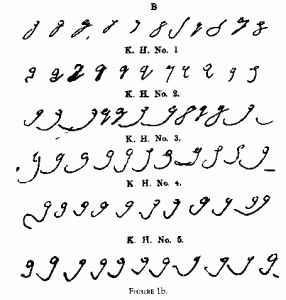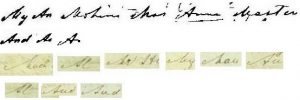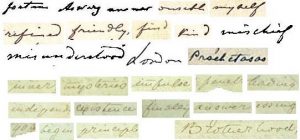HPB, Handwriting
and the Mahatma Letters. Part 2
If a person wants to disguise his or her handwriting from an expert he is up against a difficult task. The amateur will think that by changing one or two things that he can pull this off, but doesn’t realize that there and many different factors that are unique to a particular writing. The most common attempted change is in the slant. This can produce the quickest and easiest instant change but is unlikely to fool a handwriting expert. The complete slant is determined by the direction of all the upstrokes and an attempt to change the slant usually results in only the longer ones being affected leaving the shorter ones unchanged – and these are the majority of the strokes. Such a change will thus affect only a small percentage of the strokes in the handwriting and can fool some but not the seasoned analyst that takes a serious look.
Interestingly the slant is roughly similar in all the sample writings so there was no overt attempt to do this.
The next thing one may do is to change the speed of the handwriting. If one normally writes quite quickly and the writing is difficult to read then slowing it down will make it more legible and alter a number of characteristics. Many of us slow down the handwriting when addressing an envelope. One will want to make sure the post office can read the correct address so the writer slows down and makes a conscious attempt to write quite legibly. As a result the slowed down writing will look quite a bit different than notes he may take from a lecture. Even so, many similarities will show up in both samples.
The third thing a person can do is to alter certain letter formations so two scripts will have a different look as one compares them.
So, is there a change in speed in the various samples?
Yes, the samples attributed to KH are written at a slower speed and are more legible than Blavatsky’s handwriting. HPB wrote very quickly and her handwriting is difficult to read. If she did write the Mahatma letters it is only logical to assume she would slow her writing down, not only to change the look, but to make the letters legible enough to be correctly read.
Were there any unusual changes or differences in letter formations?
Between the writing samples I have of HPB and the 1880 KH samples there are no changes that couldn’t be attributed to a change of speed. However, the biggest changes on letter formations occurred within the Mahatma letters themselves.
Hodgson noticed this and pointed it out. He noticed that the small fs and the Ys and Gs changed in the letters as time progressed. The changes in the latter over a four-year period were most pronounced as you can see in the sample below.
Normally the writing of a seasoned adult does not change like this unless a conscious attempt was made to do so.
The Theosophists explained that KH may have had a scribe do part of the writing, but the evidence is strong that they were all written by the same person. And it doesn’t make much sense that KH would use a scribe.
That said let us take a close look at the handwriting of HPB and the letters, for if she wrote any of them she undoubtedly wrote all the samples I have.
When two handwriting samples are presented before me with the question as to whether they were written by the same person the first thing I look for are unusual characteristics not found in most handwriting. If even one thing shows up in common then this is evidence that I need to look further. If two or more show up then the chances become strong that the two writings were from the same individual.
Are there any such unusual traits in common between HPB and the 1880 Mahatma letters? Indeed there are. Let us look at a few.
In both samples the beginning capital T and some other letters begin with a large loop with the letter formations being quite similar. Take a look. The writing on the top belongs to HPB and the bottom KH.
Another odd thing in HPB’s handwriting is she often begins her letters with a large hook. A small hook is quite common but a large one like hers is fairly unusual. Notice that the KH writing (bottom two lines) shares the same characteristic. Also notice the similarities between the capital As.
HPB has the unusual habit of crossing two separated Ts with one stroke. Notice the KH writing on the bottom has the same characteristic.
Some very unusual strokes show up in some of HPB’s small Ds. Normally her writing slants strongly to the right, but then her D ‘s make an abrupt swing to a backhand while incorporating a large loop. This change is highly unusual and this trait is also found in the KH writing. (Always on the bottom line)
HPB’s writing has the unusual characteristic of having large gaps between letters that are generally connected within a word in a cursive script. Most of us have significant space between words, but not letters within a word. Now small breaks between letters are common in cursive, but not large ones. Take a look. The top three lines are from HPB and the bottom three from the 1880 KH letters.
These and other similarities give pretty powerful evidence that HPB wrote the Mahatma letters with her own hand. It would be highly unlikely to find these and other anomalies in the writings of two different people.
Next we’ll look at some of the general characteristics of the two handwritings and see how they measure up.
Copyright 2016 by J J Dewey
Index for Recent Posts – includes this series
Easy Access to All the Writings
For Free Book go HERE and other books HERE
JJ’s Amazon page HERE
Gather with JJ on Facebook HERE





